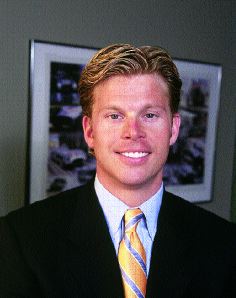
THE CHANGING FACE OF THE INDEPENDENT AGENT
Dirk Fournier is setting--and meeting--high standards for himself and his agency
By Elaine Tolen

Dirk K. Fournier is president of Oregon Insurance Agency in Portland, Oregon, as well as vice president of Fournier Insurance Group, Montesano, Washington.
One of Dirk K. Fournier's goals in life was to buy his own insurance agency by the time he reached 30. He realized that goal at the age of 29, when he bought the Oregon Insurance Agency (OIA) in Portland. From the first cold call to closing, the deal took a whopping six months. Buying OIA in 2000 was just the beginning of a bold, new approach to growing an independent insurance agency. Dirk's aggressive and progressive strategies are reaping dynamic results at OIA as well as at the Montesano, Washington-based Fournier Insurance Group, where he is vice president.
In 1977, Dirk's father, Dick Fournier, entered the insurance industry as a life agent after a career in teaching. Later, he became a P&C producer and opened his own agency (now called Fournier Insurance Group). Like his father, Dirk was born and reared in Montesano, Washington, a small town about 100 miles southwest of Seattle.
When Dirk was 13 years old, he began working at the agency on weekends, doing janitorial-type work. "I'd clean the bathrooms, empty the wastebaskets, change lightbulbs, whatever needed to be done," Dirk recalls. By the time he was 15 and working after school at the agency, Dirk got a bit of a promotion, becoming a "go-fer"--filing, answering phones, doing home inspections on new business.
"But," says Dirk, "I always had a passion for sales. Whether it was a school or community fundraiser, I always wanted to sell the most of whatever it was we were selling. I also had a strong entrepreneurial spirit from an early age--wanting to own my own company. My father owned his own agency so it was a natural fit for me.
"However, going into the insurance business was by choice," Dirk emphasizes. "I didn't decide to go into insurance by default like many second- and third-generation owners do. I chose insurance as a career because I love it."
In the summers while he attended the University of Washington, Dirk continued to gain experience by working in different areas of the Fournier agency. The first summer, Dirk earned his P&C license, which allowed him to move into personal lines production and CSR work. The next summer, he did service work in personal and commercial lines and the third summer, earned his life and health license, and began working in that area. The summer after graduation, Dirk did sales-related work, including making cold calls. "Walking" in each position's "shoes" paid off, because "my employees can't tell me, 'You don't know what I'm going through,' because I do. I've been there," Dirk says.
After graduating in 1994 from the University of Washington, Dirk went to work in SAFECO's claims department for two and a half years. "It was the toughest job I've ever done," Dirk remembers. "You're dealing with people who have problems and are upset. It was physically and mentally taxing."
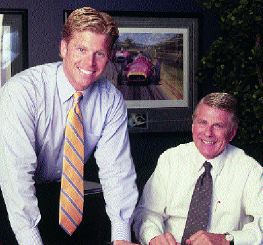 When Dirk Fournier acquired Oregon Insurance Agency in 2000, he also gained a mentor and friend in the agency's owner, Martin K. Bowes (seated).
When Dirk Fournier acquired Oregon Insurance Agency in 2000, he also gained a mentor and friend in the agency's owner, Martin K. Bowes (seated).
While Dirk was at SAFECO, Dick Fournier acquired a large agency that doubled the agency's volume overnight. This presented Dirk with a career choice. "Dad had no one to run personal lines. SAFECO wanted to promote me, and I was getting offers from other agencies as well. I decided that going with my dad's agency was a good opportunity."
At the time, Fournier Insurance Group had eight offices in Washington, and Dirk spent a lot of time visiting those offices (as evidenced by putting 50,000 miles on his car in one year). During this time, he moved from Seattle to Portland and took on more operational responsibility within the agency.
Prospecting for gold(en clients)
Although he enjoyed the opportunity of being a principal in the Fournier Insurance Group, Dirk was ready to strike out on his own. So he began searching for a possible agency to acquire. He went through the Yellow Pages, looking for agencies that represented the same carriers as the Fournier agency did. Dirk took the initial prospect list to his carriers, asking them which agencies had succession plans and which ones might be most amenable to a merger or acquisition. Using the companies' input, he ranked the agencies, then set out to conquer.
The first agency Dirk approached was Oregon Insurance Agency, established in the 1930s. "I called the owner, Martin Bowes, and asked if he had a perpetuation plan and if he'd be open to selling his agency," Dirk explains. Martin invited Dirk to the agency to discuss the possibilities, and six months later at the age of 29, Dirk owned his first agency.
When Dirk acquired the Oregon Insurance Agency, he acquired more than just a business. "Martin has become a friend and mentor to me," Dirk says. "Martin sees my vision. He taught me about the potential that large commercial accounts offer. Because of him, the agency began concentrating more on larger commercial business."
Since buying OIA in 2000, Dirk has acquired three additional agencies and is working on a fourth acquisition. Dirk says it's important not to take a "cookie cutter approach" to mergers and acquisitions. "Most agencies follow a structured format to handle mergers and acquisitions. But each one is different and you have to be flexible to meet the owners' varied needs as well as the needs of the agency."
As president of Oregon Insurance Agency and vice president of Fournier Insurance Group, Dirk collaborates with his father to make joint decisions regarding the organizations. Even though each agency has some variations in markets, combining both agencies to coordinate markets gives them better leverage, according to Dirk.
Collectively, the two agencies grew by 40% last year. In June 2002, the organizations had $5.2 million in revenue. The elder Fournier plans to retire in July 2005, and Dirk projects that the combined revenue of the agencies at that time will be $8 million. He predicts that by 2007, the agencies will have doubled the current revenue to reach $10 million. "We want to be a regional player in this part of the country," Dirk says.
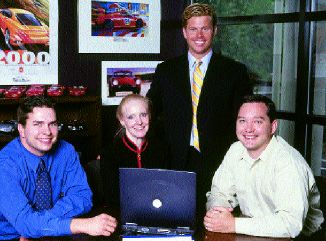 Dirk (standing) attributes much of Oregon Insurance Agency's recent success to Mary M. Eisenhart (seated, center), CPCU, ARM ARe, RPLU, CIC, CIPW, who has been instrumental in restructuring the agency's operations and organization. Robert Sloan (seated, left) and Tim Deggendorfer (seated, right) are part of the agency's progressive staff.
Dirk (standing) attributes much of Oregon Insurance Agency's recent success to Mary M. Eisenhart (seated, center), CPCU, ARM ARe, RPLU, CIC, CIPW, who has been instrumental in restructuring the agency's operations and organization. Robert Sloan (seated, left) and Tim Deggendorfer (seated, right) are part of the agency's progressive staff.
OIA and Fournier Group employees share in the agencies' financial success. Every year, the agencies come together for an employee appreciation day. The agenda of the celebration is determined by contingency income from the agencies' carriers. "This year was a great year," Dirk reports. "We took all 60 employees and spouses or friends on a murder mystery train that goes to Mount Hood. We served dinner, had an open bar. It was a lot of fun." Last year, the contingency income wasn't as high, so the agencies had a Monte Carlo bowling night. "It was still very nice," Dirk says, "We had dinner and offered cash prizes."
Secret Weapon #1
Part of the agencies' recent growth is due to internal changes in operations and staffing, according to Dirk. To reorganize and restructure OIA, last year Dirk brought in consultant Mary M. Eisenhart, CPCU, ARM, ARe, RPLU, CIC, CPIW. Dirk met Mary six years ago at a conference "at which she was the only non-boring speaker," he reports. Over the next few years, Dirk and Mary kept in touch and she did consulting for the Fournier Insurance Group. Dirk saw that she could be the key to taking OIA to the next level. "I told her she could use my agency as a lab and re-vamp the whole operation. I offered her the opportunity to take an established agency and create a new organization," says Dirk. "It was a win-win for both of us."
As an independent consultant, Mary counsels agencies on how to change their structure, procedures--whatever can improve agents' performance and agencies' success. Dirk says that Mary's insurance background, energy, connections and knowledge "have helped put us on the map."
In June 2001, Mary merged her consulting practice into OIA. While continuing to work with outside clients, Mary runs the agency's operations. "I've always been strong in operations," says Dirk, "but Mary is stronger. She shares my vision on how the organization should be run. She and I are very detail-oriented and committed to quality. Besides totally changing the agency's internal structure, Mary has helped our acquisitions go more efficiently and quickly. She's the only person who hasn't told me to slow down. In fact, she says, 'Keep going, I've got your back.'"
Change is a constant
Part of improving the agency's infrastructure since Mary's arrival has been re-writing OIA's procedures manual and producer contracts. The six-inch thick, "comprehensive" manual has changed just about every method in the agency, says Dirk.
For example, CSAs now have a "uniform desk setup" which helps them organize and manage workflow more efficiently. Most desks have just two baskets--In and Out. Dirk explains that the acceptable industry standard of time for processing items is 3-5 working days for commercial lines and 1-3 days for personal lines. So, each commercial lines CSA has a five-color-coded file system at his or her desk, and each personal lines CSR has a three-color-coded file. Incoming items are placed in one of the files, in date order, with the oldest item on top. One color file is handled per day. "The idea is to handle the phone calls and "critical" items coming in each day," says Dirk, "plus the items in at least one of the color-coded files." E-mail and e-faxes are also categorized into color codes. This desk setup combines with electronic transactional filing (See "Secret Weapon #2) to provide a highly efficient organization.
In the personal lines area, the agency has just implemented a centralized service process. "Most agencies divide clients up alphabetically. One CSA might have several clients waiting to be serviced, because of the way work is divided, while another CSA might have none," explains Dirk. "There is a tendency for CSAs to build fences around their clients and get proprietary. This can hurt client service and employee relationships." OIA's new system's matrix rotates accounts, so all CSAs handle every account. "Not only does this provide immediate service to clients," says Dirk, "everyone is monitoring the agency management system to make sure things are being done properly."
In the commercial lines area, recent changes include requiring a full narrative on every new business account. "Typically, producers don't fully complete applications. We want applications to be perfect, including the narrative. This differentiates us when the account goes to the underwriter and makes the insurance company feel more comfortable about the account. It also helps the CSAs better service the account," explains Dirk.
All this internal reconstruction took a lot of time, according to Dirk. "Everyone worked nights, weekends, holidays. We paid $30,000 in overtime from November 2001 through February 2002. But the work paid off and we're a stronger organization," says Dirk. "It wasn't easy. It's hard for people to change at the pace we're asking them to change. We lost some employees who didn't share our vision."
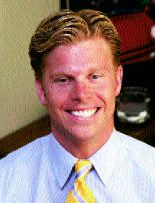 "One of the biggest keys to success in the insurance industry ... is perseverance ... Only those who stay focused and committed will succeed."
"One of the biggest keys to success in the insurance industry ... is perseverance ... Only those who stay focused and committed will succeed."
--Dirk Fournier
The agency's new producer contracts include a performance-based compensation plan. Dirk says the plan allows producers to be vested 50% over five years. Commissions are front-end loaded, giving the producer 70% commission for new accounts and 20% commission on renewals. "Some people might think we're crazy to pay this way," says Dirk, "That's a lot to pay on new business. But it puts strength behind the producers and is an investment in the agency. It encourages producers to keep seeking new business."
Attracting new producers has been no problem at OIA. "Potential producers come to us," he says. "They see the agency's youth and sales potential as well as the good compensation structure. They want to be part of a dynamic organization."
When bringing in producers, Dirk does not put them in personal lines--where new producers usually start. "It's hard to succeed in personal lines. There's not enough of a revenue stream to motivate good salespeople in personal lines. It's just as easy to write a BOP," Dirk says. So, new producers begin in commercial lines.
To reap the benefits of the generous compensation program, producers must live up to high expectations. "We want excellence and results," Dirk says. To achieve those goals, producers have a set of performance principles to follow. These include not pursuing accounts that are less than $5,000 in revenue, and maintaining a high-level relationship with clients. "We want insurance issues to be secondary," explains Dirk. "We want to help our clients' businesses succeed."
Dirk also meets weekly with producers to set goals and discuss accounts. The goals include a specific number of weekly prospect calls and appointments. Closely monitoring producers' performance, Dirk wants to know: " 'How many letters have you sent out? How many contacts have you made? How many appointments have you set up?' Some people would say I micromanage. Oh, well," he says with a shrug.
Secret Weapon #2
While most agencies piggy-back information technology responsi-bilities with another job, like the accountant or lead CSR, Dirk has brought in a full-time IT director. Through Mary Eisenhart, Dirk got to know Mary Burger, an insurance technology consultant who has been in the industry for 15 years. She is also author of the book Making Money the New-Fashioned Way, a study of how technology affects the insurance industry.
"Taking advantage of economies of scale, Mary [Burger] handles IT for both OIA and Fournier Group," Dirk explains. "Between the two agencies we had four separate data systems which were not completely linked. We now have one system. In 60 days, she centralized the server and server room. She has taken us to a new level of automation."
Part of that new level has been the implementation of electronic transactional filing (T-filing) in personal and commercial lines. The basic premise of transactional filing is organizing documents by date of service instead of by alpha. Dirk says this method has already saved a lot of time, since any encounter with a customer is noted on the computer and cross-referenced to the transactional files, which are organized by date. "No more running around the office, trying to find which desk the Smith file is on," comments Dirk.
"While T-filing in its original form is not a "paperless" system, it becomes so through imaging technology," he continues. The agency is using the Ricoh E-Cabinet Solutions system, which includes imaging and document storage as well as copy and fax capabilites, to become a totally paperless office. All incoming mail is high-speed scanned, then distributed electronically to the proper employee, Dirk explains. Color-coded folders in E-Cabinet help employees organize workflow.
To improve internal communica-tions, Mary developed an intranet for personnel, human resources and other internal business.
In addition, she installed third-party software on the main server, which allows her to remotely load programs on each computer. Before that, going to each of the agencies' 10 offices and installing software on each employee's computer "was a logistical nightmare," says Dirk.
"She made all of these changes in 11 months. No wonder we named her Employee of the Year even though she had been here less than one," Dirk says.
New models
In addition to OIA's commercial and personal lines, the agency has recently created a financial services department, which provides benefits products and life insurance, as well as assists clients in buy-sell agreements, splits, etc. Dirk says that while the financial services department is only 5% of the agency's revenue right now, he forecasts that in three years it will represent 25% of OIA's revenue. "This area is growing and lucrative, and expanding services is necessary for agencies to survive," he says.
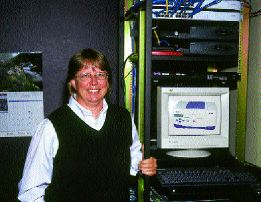 Most agencies don't have a full-time information technology director, but Dirk saw the position's potential and hired insurance technology consultant Mary Burger as IT manager.
Most agencies don't have a full-time information technology director, but Dirk saw the position's potential and hired insurance technology consultant Mary Burger as IT manager.
Another creation of the agency's new infrastructure is the sales center. The sales center employs a full-time person to target the type of clients that the agency wants and make initial contacts. "Producers are not marketing people. You can't expect them to produce if they're behind a desk, doing marketing work." Dirk believes that the sales center approach will help OIA obtain larger commercial accounts.
The sales coordinator utilizes an inside database to target potential accounts of at least $5,000 in revenue and develop a potential customer profile. A marketing letter is generated (signed by Dirk), and the producer follows up. But here's the rub--rarely does the process get to the producer for following up. Which, Dirk says, in most agencies equates to a failed sales attempt. On the contrary, "Prospects are calling us!" says Dirk. "I am astounded. In the marketing letter, though, we give them something practical they can apply to their business--maybe a magazine or newspaper article reprint." Dirk credits this marketing concept to Mona Carpenter, a veteran sales consultant to the insurance industry.
Standing out from the crowd
"Every agency says that service sets them apart from others, but clients and prospects don't really know what that means," observes Dirk. "The goal of our agency is to have a 'boutique' relationship with our clients. When you shop at a boutique rather than a department store, you get more focused, personalized attention. The clerks know the customers' tastes. The customers know that the clerks will call to advise them when merchandise they like comes in. We're like that. We want to be a good resource for our clients. We want to help them perpetuate their business.
"I also believe that the proactive nature of our employees and our progressive approach to service sets us apart," says Dirk. The high level of professionalism adds to employees' abilities, according to Dirk. "All 23 employees at OIA are licensed except Mary Burger (IT) and the accountant. Even the receptionist is a college graduate who wants to learn more about the insurance business. I probably pay him more than most receptionists," says Dirk, "but he also does ten times more work than most. Basically everyone in the office can write accounts."
Certification and continuing education are important factors in continuing to raise the bar, says Dirk. Commercial lines managers are working on the ARM designation, while CSAs in personal lines are earning the API designation. Dirk has earned the CIC designation and is working on both the API and ARM designations.
Hard market experience
Dirk is one of just a few young insurance professionals who have actually experienced a hard market prior to the current one. "I've been in the business for 18 years, and I do remember the last one," he muses. "I remember there was a moratorium on the amount and type of insurance you could write. With every auto application, you had to submit a property application."
One of the biggest problems in today's hard market, according to Dirk, is that most underwriters have never underwritten in a hard market. "Few of them have seen a hard market. They need to be creative in mitigating rate increases. Mary [Eisenhart] even had to teach one underwriter how to read a worksheet," he says.
"We've always focused on carrier relationships, and in the hard market these relationships are more important than ever," Dirk continues. "Although the dynamics have changed somewhat because each side is a little cautious."
The future of the industry
Within the next five to 10 years, Dirk predicts that agencies will rely more on contingency income and less on commission income. "I know that sounds radical," Dirk says, "but renewal commissions are already declining. For instance, one carrier has lowered its commission to 8%. My dad taught me the importance of contingencies--not to depend on them for operations--but to use them in expansion. We use them on ourselves, to improve our producers and infrastructure." He says agencies will focus on new business, with more front-end loaded and back-end commission.
Another challenge, according to Dirk, is the graying of the insurance industry, "yet young people are not being encouraged in the industry. Industry leaders talk about getting young producers involved, but they don't practice what they preach. Look at national associations--their executive boards are not very diverse," Dirk points out. "In many cases, older professionals need to change their perspective on how to bring new people into the industry. They need to make it attractive, for instance, by changing commission splits, offering base salaries and allowing flexible schedules and workplaces."
With or without support from outside organizations, Dirk sees great potential for young agents. "One of the biggest keys to success in the insurance industry--if not the key--is perseverance. One must become committed to achieving success and not letting up in the early stages of the career. The learning curve is steep in this industry and new sales don't come easily at first. Only those who stay focused and committed will succeed." You can say that Dirk Fournier is focused and committed--and successful. *